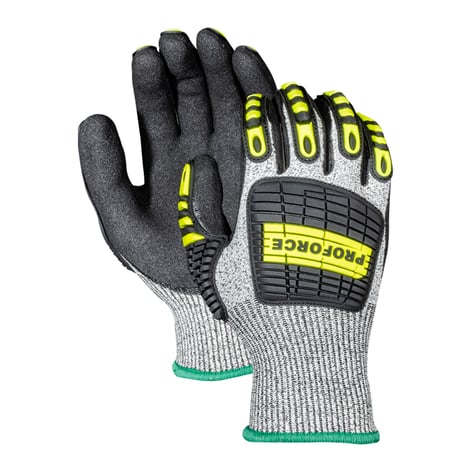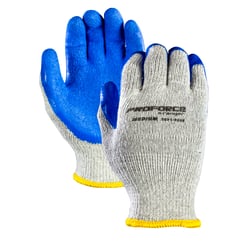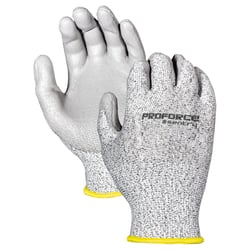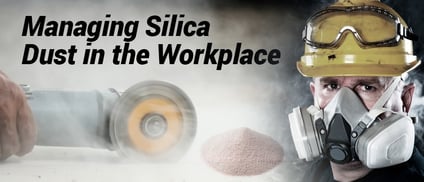Whether you’re a veteran of the industry, or have years of experience under your belt, reading about the importance of wearing gloves while working can sound like being lectured.
Perhaps you feel that wearing gloves makes your hands sweaty, or that gloves are a necessary evil.
Regardless of your thoughts about wearing gloves, not wearing them properly play a significant role in the occurrence of workplace injury. The US Bureau of Labor and Statistics (BLS) reports that a significant portion of hand injuries resulting from a visit to the emergency room was due to people not wearing gloves.
The Occupational Safety and Health Administration (OSHA) cites a myriad of hand injuries that you can routinely face as a contractor, including skin absorption of harmful substances, chemical or thermal burns, electrical dangers, bruises, abrasions, cuts, punctures, fractures, and amputations.
“Hand and finger injuries are the second most common work-related injury,” Aramsco Product Manager, Jennifer Miller said. “An average of 100,000 people lose time at work due to hand injuries, which can be dramatically reduced with knowledge and the correct tools to do so,” Miller emphasized, citing BLS data.
Despite all of the scary statistics, the good news is that almost all hand injury on the job is avoidable by implementing proper glove safety practices.
There are many benefits that will result from creating a glove safety plan
- You can avoid costly liability: Emergency room visits for hand injuries cost $6,000 on average.
- Your hands are one of your most valuable assets: An injury to them will drastically cut your productivity. By protecting your hands you will be able to continue to perform the fine motor skills and functions that are required on the job.
- You will build trust and a commitment: Get the job done the right way by showing your employees that you value their safety
- Show your customers that you are a true professional: Your customers hired you to perform a service that adds value to their lives. Gloves give a professional appearance and show that you take your work seriously.
The 3 Things to Remember When Selecting the Proper Glove

With this in mind, there are best practices that you should follow for selecting and wearing gloves.
Choosing the right glove doesn’t have to be time-consuming. The best part of modern glove manufacturing is that innovations in design have led to comfortable technology that doesn’t sacrifice performance.
OSHA has developed a set of Personal Protective Equipment (PPE) guidelines that will protect your team while working. They recommend that gloves be selected based on the task that will be performed, the chemicals that you will encounter, and the construction of the glove material.
Below is a simplified breakdown I’ve developed that incorporates these standards and can be used to make a glove plan for your company.
Note that it’s important to think ahead and ask yourself these questions before beginning each job. Although many of the workplace environments that you encounter every day will be similar, it’s essential to assess the situation beforehand so that you’re not underprepared.
Always ask yourself these three simple questions in order to put together a glove safety plan for each job:
1. What task will you be performing?
The nature of many jobs involves unavoidable hazards. You need to conduct a thorough review of what you will be doing, so that workplace safety controls can be identified. You should walk through the job site first, and survey the area for potential dangers. While you do this ask yourself questions such as:
- What is a complete description of the task(s) involved?
- How much flexibility and touch sensitivity do your hands need for the task(s)?
- Will you be working with materials like concrete or drywall that can have rough or sharp edges?
- Will you come into contact with sources of electricity or temperature that can result in burns or shocks?
- Are there loose objects that can drop or fall?
2. What chemicals are you going to encounter on the job?
For this step, identify which chemicals your hands will come into contact with and ask these questions:
- How long will your hands be in contact with the chemicals?
- What is the nature of the contact (i.e. splash, continual immersion, etc.)
- Will you come into contact with blood or other biological material?
- Can the gloves be washed after exposure, or do they need to be disposed of after use?
These first two steps are part of what OSHA calls a “hazard assessment.” A hazard assessment should be conducted on a reoccurring basis throughout the duration of the job as work conditions change; all changes should be accounted for in your glove safety plan.
3. What material is the glove constructed out of?
Not all gloves are built equally, so it’s important to pick one that sufficiently meets the needs of your current job.
If you have completed the first two steps, you likely have a good idea about what glove will meet the standards that you identified above.
Now it’s time to select a glove. It might come as a surprise when looking at the chart, but there’s a glove for everything!
Many websites provide spec sheets that give detailed information about the performance ratings and features of their gloves to help you in narrowing your search.
On our ProForce Armor glove page, you can download the spec sheet for our ProForce line of gloves under the “related documents” tab.
An initial look at the chart shows how each type of glove performs against impacts, cuts, dexterity, and grip. For example, if you are doing restoration work and are handling material with rough or sharp edges, our ProForce Armor gloves feature HPPE ANSI-A3 cut-resistant stitching.
In 2016 ANSI and ISEA (The International Safety Equipment Association) published a scale that covers 9 different levels of cut protection measured in grams of pressure a glove can hold before being cut through.
You can use this scale when checking the label on the glove under consideration to see if it meets the standards needed for your job.
- A1: 200 - 499 grams
- A2: 500 - 999 grams
- A3: 1000 - 1499 grams
- A4: 1500 - 2199 grams
- A5: 2200 - 2999 grams
- A6: 3000 - 3999 grams
- A7: 4000 - 4999 grams
- A8: 5000 - 5999 grams
- A9: 6000+ grams
By Creating a Glove Strategy You Add Value to your Business
Of course, wearing appropriate hand protection is only one part of the equation that your business should follow for developing a comprehensive PPE strategy, but it will go a long way; as a business owner, having a glove protocol in place will put your business in a favorable position, protect you from being sidelined, and ensure that your customers and employees trust your work practices.
Save this article to your phone and use it at the beginning of each job to create a glove safety plan. You don’t have to go out of your way to see the immediate benefits that come from making your job site a safer place.
For further help with creating a glove safety plan, OSHA has consultative services and other informational material about creating a comprehensive protective strategy available for free on their website. You can also talk with representatives at any of our locations on how to apply these principles at work.
Featured Products

ProForce Armor Gloves Nitrile Coated Palms and Fingers Size L, Sold by the Pair

ProForce Ranger Gloves Cotton Blended Shell Size L, Sold by the Dozen

ProForce Sentry Gloves Nitrile Gray Size L, Sold by the Dozen
Enjoyed reading this post? Read the following articles:




